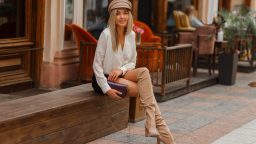Layering is an essential skill in fashion that can elevate your wardrobe, adding depth and dimension to your outfits. However, for many people, mastering the art of layering can be tricky. Too many layers, and you risk looking bulky; too few, and you miss out on the opportunity to create stylish and functional outfits. If you’re a beginner looking to master layering, don’t worry! Here’s a simple guide to get you started with easy tips and tricks that will help you layer like a pro.
- Start with the Basics: The Foundation Layers
When it comes to layering, everything begins with the basics. These are the foundation pieces that will serve as the building blocks of your outfit. The key to mastering layering is to make sure your base layers are fitted but not too tight.
- Tops: A well-fitted t-shirt, blouse, or thin knit sweater should be your starting point. Neutral colours like white, black, grey, or beige work best as they provide a versatile base for any outfit. These pieces should be lightweight and breathable to ensure comfort when adding more layers on top.
- Bottoms: Start with tailored trousers, leggings, or jeans that you feel comfortable in. Dark jeans or neutral trousers are great because they pair well with almost anything, creating a solid base for your layers.
Foundation layers are essential for ensuring that your look remains sleek and stylish, even as you add more pieces on top.
- Add a Mid-Layer for Warmth and Texture
Once you’ve got your base layers in place, it’s time to add a mid-layer to provide both warmth and texture. This layer should be something slightly thicker than your base, like a sweater, cardigan, or lightweight jacket. The mid-layer adds dimension to your outfit and can be a great opportunity to experiment with different textures, patterns, and colours.
- Sweaters and Cardigans: Opt for cashmere, wool, or cotton, depending on the season. A chunky knit sweater or an open-front cardigan can add texture and make your outfit feel cozier. Neutral shades work well here, but don’t shy away from adding subtle pops of colour or pattern.
- Shirts: Button-up shirts or blouses can also serve as mid-layers. You can wear them under a sweater or a jacket for an added layer of sophistication.
Mid-layers are an opportunity to mix and match different fabrics, so feel free to experiment with cotton, wool, denim, or leather.
- Outerwear: The Finishing Touch
The outer layer is the final piece that brings your whole look together. This is where you can play with style and personality while ensuring that you’re prepared for the weather. Outerwear pieces such as jackets, coats, and blazers are essential for both fashion and function.
- Blazers: A tailored blazer can instantly add polish to your layered look. It’s versatile enough to wear over both casual and dressy outfits, and it adds structure and sophistication.
- Jackets and Coats: A stylish coat, like a trench, puffer, or leather jacket, will provide both warmth and style. Trench coats are timeless and can easily be worn with almost anything, while a leather jacket gives a cool, edgy vibe.
- Denim Jackets: For a more laid-back look, a denim jacket is a perfect outer layer. It adds casual coolness to any outfit, whether you’re layering it over a sweater or a t-shirt.
The key to mastering outerwear is to ensure it complements the layers beneath it. Choose pieces that work in harmony with your mid and base layers while keeping the overall silhouette balanced.
- Play with Proportions
One of the most important things to consider when layering is the proportions of each layer. A successful layered outfit is one that looks balanced, with each piece complementing the others.
- Length: Play with different lengths to create visual interest. For example, pair a longer cardigan or jacket with a shorter top to add balance. Alternatively, a cropped sweater or jacket can be paired with a longer shirt underneath.
- Volume: If you’re wearing a bulky sweater or oversized jacket, balance it with a slimmer base layer or tailored trousers. On the flip side, if your base layer is fitted, consider adding a looser mid-layer to create contrast and avoid feeling too restricted.
Balancing proportions will help ensure that your layers don’t overwhelm your body shape, making the overall outfit feel cohesive.
- Use Accessories to Tie It All Together
Accessories are the perfect finishing touch to any layered outfit. They can add personality, colour, and extra warmth when needed. Scarves, hats, and jewellery can all enhance your layered look and give it that extra flair.
- Scarves: A scarf can be a stylish and practical accessory, especially in colder weather. A chunky knit scarf adds warmth and texture, while a silk scarf or shawl can introduce a pop of colour or pattern.
- Hats: Hats like beanies, fedoras, or wide-brimmed styles are great accessories for layering. Not only do they add style, but they can also provide extra protection against the elements.
- Jewellery: Layering necklaces or stacking bracelets can add depth to your outfit. Opt for delicate pieces for a more refined look, or mix chunky statement jewellery with your layers for a bolder style.
Accessories are a great way to elevate a layered outfit without overwhelming it.
- Layer for Weather and Function
While layering is an art, it’s also a practical way to dress for the weather. Always keep in mind the temperature and your comfort when choosing your layers. In colder months, you’ll want to layer thicker fabrics and add more insulating pieces like thermals or wool scarves. In warmer months, lighter layers, such as cardigans or a lightweight jacket, will allow you to stay comfortable without feeling overheated.
The beauty of layering is that it’s adaptable, and you can easily add or remove pieces depending on the weather or the occasion.
Final Thoughts
Layering is an easy way to make the most of your wardrobe and create stylish, functional outfits all year round. By mastering the basics of layering, you can mix and match different pieces to create a variety of looks, from casual to chic. The key is to start with well-fitted base layers, experiment with textures and proportions, and choose outerwear that adds both style and function. Once you get the hang of layering, you’ll be able to dress effortlessly, no matter the season or occasion.





